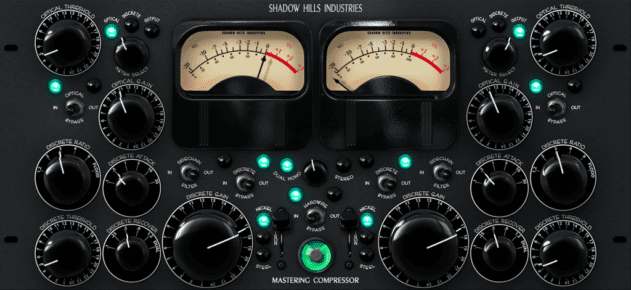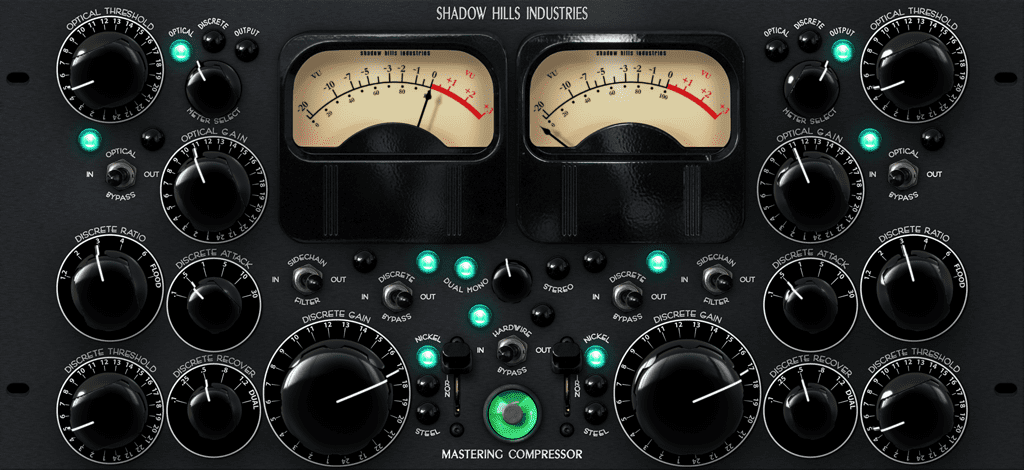Another excruciatingly expensive hardware compressor gets the Universal Audio emulation treatment. Is this circuit-modelled plugin only fit for mastering? We put it to the test.

Shadow Hills Industries’ highly coveted – and equally highly priced – Shado Hills Mastering Compressor is the latest addition to the long list of classic studio hardware offered in software form by Universal Audio. In developing the plugin, UA joined forces with Shadow Hills’ Peter Reardon
and occasional collaborators Brainworx
(who dipped their toes into the water of circuit modelling just over a year ago with their emulation of Vertigo Sound‘s VSC-2 compressor).
The Shadow Hills unit is widely considered one of the finest mastering compressors available. To cut straight to the chase, the emulation works like a dream for stereo mix bus treatment or light cosmetic touches to the final master. That’s perhaps needless to say given Universal Audio’s track record, but for those who aren’t familiar with the sound of the original, what does the plugin offer?
The combination of a relatively subtle optical compression circuit routed in series with a more aggressive discrete (VCA) stage allows for a range of effects, from light dynamic control through to aggressive compression more suited to parallel compression techniques. On that front, it would have been nice to see an adjustable mix setting to allow parallel processing without the need for any further routing in the DAW.
Masters of the universe
Don’t let the presence of the word ‘mastering’ plastered across the front of this plugin fool you into thinking it’s a one-trick pony. Further use reveals its ability to process a wide range of signals. One particular highlight is its ability to treat a drum bus. The dual compression stages allow huge flexibility in terms of dialling in musically appropriate settings of gain reduction, attack and recovery (release).
The optical stage takes the tried and tested LA-2A approach to user controls, offering nothing more than a threshold control and a make-up gain setting. Attack time is fixed and release time is programme-dependent (according to Shadow Hills, “80% [of the gain reduction] is recovered quickly, while the last 20% takes over a second, depending on the amount of attenuation applied”). The discrete section offers the standard threshold, ratio, attack, release and make-up gain controls.
The combination of the optical and discrete stages also makes the plugin extremely versatile. It’s just as capable of taming peaks as it is gluing elements of a mix or increasing overall loudness. The ‘flood’ (brick wall/limiting) ratio setting in the discrete stage will even happily smash the living daylights out of your signal if you ask it to.
This audio example shows how the compressor has brought out the low end of this drum and sub groove, hugely increasing punch without sacrificing detail:
Audio Player Audio PlayerOne of the interesting features of the plugin is its ability to treat the left and right channels either as a stereo pair or independently. Not only does that mean that each channel can compress separately if required, helping to maintain the stereo image, but it also allows different settings to be applied to each channel.
Admittedly there aren’t many occasions when you’d want to use dramatically different settings on each channel of a stereo signal, but in combination with a mid/side decoder such as Voxengo’s MSED
, this flexibility also allows the mids and sides to be compressed independently – a technique most frequently used by mastering engineers but which also has interesting creative potential for producers.
Conclusion
Keeping in mind that the original hardware compressor is aimed primarily at the high-end mastering market, the Shadow Hills plugin’s main strength isn’t in obliterating material but in bringing out subtle nuances of the signal, taming dynamics and smoothing things out without losing musicality. As such, I would recommend the unit for what it does, but I would be wary of using it as a go-to compressor for material which needs a lot more punch. That being said, the sidechain filter on the unit is very effective, making it useful as a final stage on material which could benefit from such treatment. The pumping of the VCA-modelled section is musical and completely customisable in regards to attack and response times.
Audio Player Audio PlayerIt’s also worth bearing in mind that the sonic range of the plugin is multiplied by options such as the switchable output transformers – nickel, iron or steel; each progressively more coloured than the last – and the independently bypassed compression stages. You could, for example, bypass the compression stages altogether and simply use the output transformers to colour the signal.
In conclusion, the Shadow Hills Mastering Compressor is great for the experienced user who is regularly looking for a very high quality compressor for use mainly on sub-mix buses and the master channel. Novices might be put off by the many options available on the unit and, though the results are genuinely of very high quality in relation to other similarly priced compressors on the market, it can take quite a fair bit of button twiddling to get the optimal results.
The Verdict
Price: $299
Purchase: Universal Audio UAD Shadow Hills Mastering Compressor
The Final Word
Highly versatile compressor with great results once you find the right settings.




12.49 AM
Great review. Funny though, I have been demoing this for 14 days now (I have to buy it to keep working, that’s how much I have been using it), and I found it very versatile on individual tracks. You can even coax the VCA circuit to give you a DBX 160 like smack that’s great for adding massive punch to snare and kick. Really surprised by that. And of course as you point out, great on more subtle tasks too.